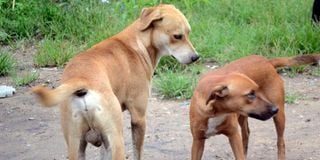Shock as Baragoi children slaughter, roast dog ‘to beat hunger pangs’

A chief reported that several children between the ages of four and eight years slaughtered a dog, roasted its meat, and ate it.
Revelations that a group of children in Seisei village, a nondescript outpost in Baragoi, Samburu North, ate a dog, have yet again lifted the lid on the drought situation in the northern parts of Kenya.
According to area Chief Tony Lesokoyo, the incident happened early this week, when several children between the ages of four and eight years slaughtered a dog, roasted its meat, and ate it.
Mr Lesokoyo said that after receiving the news, he headed to the village that has 140 households and confirmed that three children had indeed consumed dog meat.
"The children were alone at home when they decided to roast and eat a puppy after telling their parents that they were in dire need of food," said Mr Lesokoyo.
The revelations bring out the picture of how starving families, in hunger-stricken parts of Northern Kenya, including Samburu, have been reduced to eating dogs and drinking dirty water to survive.
There are scenes of despair in the drought-ravaged Ejuk village in Samburu North, where the incident happened, with most people desperately needing urgent life-saving support.
According to a local administrator in the region, the children slaughtered the dog and cooked it over an open fire "and this is not the first time".
Most families in Ejuk village and adjacent regions are reportedly going through a rough time, with no one to come to their aid due to the tough economic times being witnessed amid the ongoing drought that has gone on for three years.
The administrator noted that more families are having a difficult time providing food for their children as drought decimates livestock, their only source of a livelihood.
Samburu Deputy County Commissioner Jackson Oloo confirmed the incident but said the circumstances under which the dog was slaughtered were not clear. Mr Oloo dismissed reports that starvation was the main reason for eating dog meat.
"I have received the reports and it is said that this was not their first time to eat dog meat," Mr Oloo told the Nation on Thursday.
"We have since established that there are a good number of goats in the said homestead (manyatta). So if they were starving, their parents would have opted to slaughter a goat instead of a dog. So it is not clear," the commissioner said.
He, however, said relief food has been supplied to the village to cushion locals who have been affected by the ongoing drought.
"Even so, bundles of relief foods have been supplied to the said village," Mr Oloo said.
The Kenya Red Cross said in February that more than half of the population in Samburu is in need of urgent support following the longest drought in decades.
When she visited Samburu on February 9, Red Cross Deputy Secretary-General Annette Msabeni said more than 55 per cent of the population in Samburu was in need of support because the pastoral region was going through one of the worst droughts in decades. She revealed that Samburu is one of the worst affected by the ongoing drought and that children under five years are malnourished.
"The malnutrition rates are very high for children under five years. Pregnant and lactating mothers are also affected and many others are at risk of getting malnourished."
The official said the Red Cross was working closely with the Samburu government to support hunger-stricken families with relief food, livestock offtake programmes, and medical outreaches.
The drought, which officials have termed as the worst in four decades, has threatened the livelihoods of nomadic pastoralists with massive livestock deaths amid a lack of water and pastures. The vast arid land is enduring one of its harshest droughts and locals have been pushed into crisis.
According to the National Drought Management Authority (NDMA), malnutrition rates for children under five continue to worsen in Samburu due to inadequate dietary intake as drought decimates livestock, the region's economic mainstay.
Data collected showed that malnutrition rates stood at 39.8 per cent compared to the previous month's rates of 36.8 per cent.
"A larger proportion of the households in the county are facing high levels of food insecurity driven by five consecutive failed rainfall seasons country-wide," read the report in part.
"Malnutrition rates for children aged under five years have been extremely critical across the livelihood zones of the county."
NDMA revealed that other factors contributing to high levels of malnutrition include an upsurge in morbidity, coupled with poor maternal practices such as poor breastfeeding coupled with low dietary diversity.
High malnutrition rates of children were recorded in Wamba North, Waso, and Ndoto wards. The majority of community key informants said that most of them were taking about 1 to 2 meals a day consisting of milled posho, vegetables, and oil.





